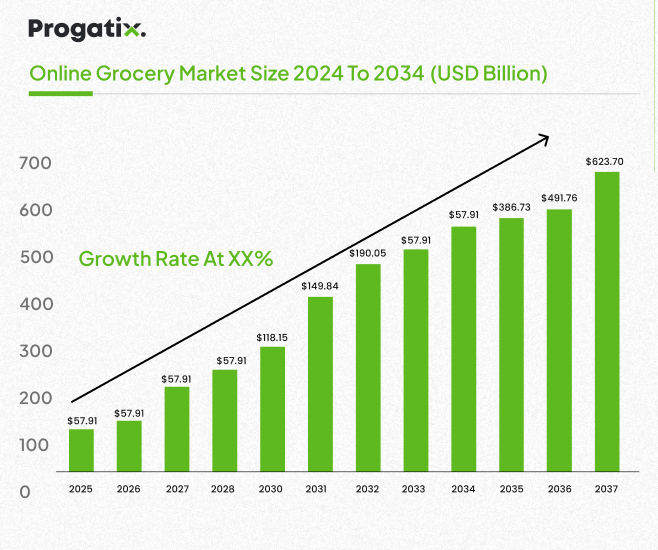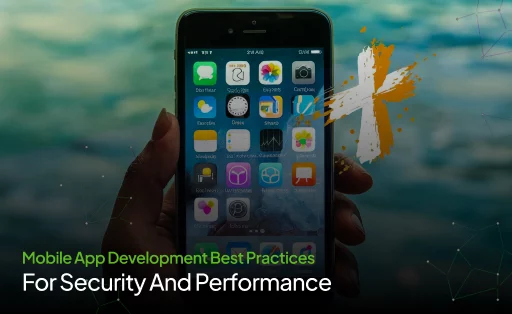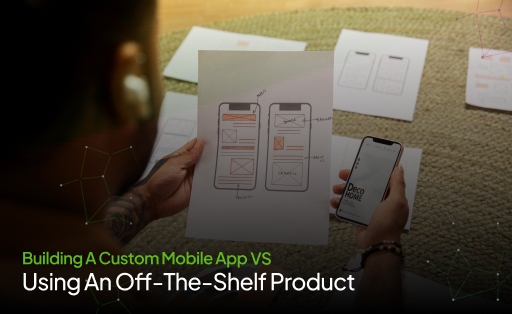A Guide To Grocery Delivery App Development App Development

For many years, going grocery shopping involved navigating crowded market aisles, standing in long checkout lines, and overlooking essentials. Grocery delivery app development, however, has revolutionized the shopping experience by making it more effective and convenient, given the technology. Powered by sophisticated algorithms and local store networks, shopping for household essentials has become simpler than before.
According to a report by precedenceresearch, the global online grocery market size was valued at USD 57.91 billion in 2024 and is projected to reach around USD 623.70 billion by 2034, increasing at a CAGR of 26.83% from 2025 to 2034. Creating grocery delivery apps can solve practical issues for many grocery business owners, both small and large.
This blog will help them examine these difficulties as opportunities to transform this repetitive practice into an ideal online buying experience.
What is a Grocery Delivery App?
A grocery delivery application allows you to purchase groceries from the ease of your home, just like an online market, but with fewer food and delivery times. It allows you to browse over a virtual catalog of the items offered at one or a few stores, add the items you require to your cart, pay directly through the app, and then wait for the driver to deliver your order to you. Beyond this crucial feature, the latest grocery delivery apps usually include an order tracking system that is GPS-based and comprises numerous personalization features that use AI and machine learning.
Types of Grocery Delivery Apps
You can choose from various grocery delivery apps, irrespective of whether your business is new or widely recognized. The most popular customized apps created and used by supermarkets are as follows:
Single Store App
You need to develop an app to represent your e-commerce business. You can use the app to manage the store’s operations, deliver groceries to customers, and update the online inventory of the groceries that are available in your store.
Grocery Chain App
This app, which is comparable to a single-store app, is recommended for owners of supermarket chains. The app’s coverage of the entire delivery area is the main distinction. With numerous locations across the globe, Walmart is one of the best examples of grocery chains’ apps.
Customized Grocery App
The best user experience is offered by this type of grocery store app, which provides a customized list of products based on the user’s preferences. Customized grocery apps can make a shopping list or wish list, set up reminders for planned or other purchases, and more. It also makes it possible to deliver some items on a regular basis.
Marketplace
You must pick your delivery staff if you’re considering using an online grocery marketplace. Some of the most successful startups are marketplace grocery stores and apps. Carrefour is a great example. It’s also among supermarket chains’ most widely used grocery delivery apps.
Aggregator
Make an app that aggregates data to assist you in organizing all of the nearby grocery stores that customers can visit. Customers can buy products from any store. After verifying the purchase, the chosen retailer delivers the food items to the customer’s door. All you have to do is make a delivery app and allow multiple grocery stores to sign up.
Features of Grocery App Development
Here are the fundamental characteristics that users look for in these types of apps. Customers must be able to access the app for grocery shopping, select the retailer from which to order food items, and complete the payment process. Restricting your options by only executing the strategies stated above is needless. However, you might offer your customers alternatives if you know people need the tools.
-
Set Up Profile
After the users have downloaded your app for grocery delivery, they will be required to sign up for an account. It is a need, as without personal profiles, users cannot follow up on orders, process payments, etc.
This feature is designed to allow customers to access all the required details and change the platform as per their references. As a business proprietor, you may prefer to use the data offered to deliver personalized services to your customers, such as sending individual messages, special offers, etc.
Developing a grocery delivery app takes your customers into account, and the opportunity to sign up on a well-known social media network is certainly acknowledged.
-
Search Engine
Users require basic tools and filter items to track down specific items or the closest grocery store, which is another essential feature that must be included in the development of grocery delivery apps. Organize all your items as per the locations, names, types, and preferences, for instance, to make it easier.
Smart lists allow people to locate the food they need and place an order fast. For instance, people can view the lists of food delivery apps, choose the nearest vendor, and then place an order.
-
Delivery Schedule
Customers must be able to schedule deliveries on the right date and time to deliver improved user satisfaction. Food items are projected to arrive fresh, though there might be a time when people cannot shop for themselves. Thus, the online grocery app’s mentioned features allow users to order fruits and vegetables whenever it’s most convenient for them.
-
Payment
It’s time to think about payment options after placing an order. Developing a grocery delivery app calls for including online payment methods. The integration of various solutions, such as PayPal, Stripe, cash on delivery, credit or debit cards, etc., makes it easier for users to finish their tasks and gives them a choice.
Ensuring the highest level of security is another important consideration in this situation. Consumers input their credit card details, which are sensitive data that need to be adequately secured.
-
Order Tracking
Your app must gain users’ trust to rank among the best grocery shopping apps. Every customer needs tools to monitor the status of their orders in order to stay active, as some orders may be delayed or, conversely, deliveries may occur earlier. Customers can unwind while waiting for their orders to be delivered due to this, and past experience has shown that it can also help guarantee that orders arrive on schedule.
-
Order Canceling
According to recent studies, customers prefer not to use grocery delivery apps that do not allow order cancellation. They will have greater faith in you if your service provides the above-mentioned option. For this reason, the parameter you selected is included in a grocery shopping app’s list of crucial features.
-
Reviews and Ratings
Customers will be able to share their thoughts about the goods and services provided by particular grocery stores if you include a grocery shopping option in your app. This typically helps consumers choose trustworthy retailers for a satisfying shopping experience. You can gain people’s trust if they are given the option to choose the best vendor.
-
Notifications
This feature efficiently notifies users of your grocery delivery app regarding events and promotions that take place now and in the future. Finding a balance is key, as is avoiding annoying people with constant notifications. It is essential to give users the ability to choose how frequently they receive notifications or block messages entirely.
-
24/7 Support
24/7 support is provided by all of the best grocery shopping apps, which is crucial in today’s world. Make sure that feature is available if you want to be part of a selected group with the best apps. Users may require help when selecting products. Ideally, a variety of options should be offered, including online chat, messaging, and phone calls. Take advantage of chatbots that offer 24/7 assistance.
Advantages of Grocery Delivery App Development
The grocery delivery apps are convenient, but they also have several other benefits. Meeting the evolving requirements of clients, maintaining a high rate of client retention, and supporting your company’s growth are few of its key advantages. The key advantages of developing a grocery mobile app are as follows:
-
Time and Cost Efficiency
It is possible to significantly lower the operational costs linked to in-store checkout and customer service. Grocery delivery apps allow you to serve more customers without hiring more staff or constructing additional space. By shopping whenever they want, customers may distribute their demands throughout the day, improving inventory control and lowering stress levels during peak hours.
The app’s features, such as its simple product comparison and adaptable delivery scheduling, will make more frequent purchases convenient while raising the average value of your orders. Eventually, this will raise your income and improve your business’s bottom line.
-
Improved Inventory Management
Grocery delivery software enables businesses to precisely collect inventory data by automating reordering procedures, managing expiration dates to reduce waste, and keeping an eye on the state of their stock in real-time. Accurate control is made attainable by features like inventory reports, a multi-store management system, and barcode scanning. This will greatly boost the profitability of your company.
-
Expand Customer Reach
A grocery delivery app development offering greater accessibility, convenience, and customization can attract more users. Email, in-app notifications, and SMS are just a few of the channels available for customer communication through the feature-rich mobile grocery delivery app. With ease and seamless transactions, stakeholders can expand their geographic reach, establish lasting connections, attract clients, and enjoy numerous additional advantages.
-
Operational Efficiency
Having a well-designed grocery delivery application that integrates various technologies can help you optimize your grocery business’s operations. Immediate stock information can be obtained through integration with inventory management software. Self-service options also improve workforce management and reduce the workload for your staff. Supply chain management could make cost savings possible through accurate data monitoring.
-
Competitive Advantages
You can provide individualized shopping experiences, quickly adjust to changes in the market, and facilitate effective inventory management through a grocery delivery app. You could also use the information collected by the app to gain a better understanding of your customer’s preferences and buying patterns.
Challenges of Running a Grocery Delivery App
At first, the owner of the app is concerned about how profitable the grocery delivery app will be in developing. You might come across some difficulties, though, if the store has unsold merchandise that you anticipate selling out. Let’s take a closer look at these issues and explore some possible fixes:
-
Smart Inventory Management
Here’s where working with a food delivery app development company can help. They can help you integrate smart inventory management so you can track stock levels in real time. This reduces waste and ensures popular items are always in stock for delivery. With predictive analytics and personalisation you can also increase sales and customer retention. A good development partner will walk you through each challenge and turn potential risks into opportunities.
-
Maintaining Product Freshness
A product catalog in an app has a number of various kinds of perishable and non-perishable items for local supermarkets. Furthermore, the extensive catalog might make finding items challenging if you do not have the right search and browse feature.
o Solution
Using tags to organize products and advanced search filters will make it easier for customers to browse through them. They can find products far quicker with the help of AI-powered product search and recommendation.
-
Ensuring Timely Deliveries
Ensuring timely delivery to customers is important for the success of the grocery delivery app. Orders occasionally arrive late due to delivery workers’ failure to deliver on time, which prompts customers to contact the delivery company to find out the location accurately.
o Solution
Customers will benefit from real-time order tracking and estimated arrival and delivery times due to the integration of the GPS navigation system.
-
Managing Delivery and Logistics Expenses
The lack of a huge, scalable database that can manage the volume of data can lead to poor logistics management. Also, inadequate preparation and optimization could result in haphazard deliveries.
o Solution
Consider collaborating with grocery app developers who can help you overcome the challenges of managing multiple deliveries at once and logistical logistics.
-
Shifting Consumer Behavior
Companies can’t predict how their customers will act out. An app’s ordering process is always changing as new features are added. A one-minute error in the process could cause dissatisfaction.
o Solution
The chances of keeping customers increase when the shopping experience is personalized. Offering loyalty, tag, and repeat order discounts or reward programs can help you keep customers.
Steps Involved in Grocery Delivery App Development
Here are the steps involved in the development of a grocery delivery app:
-
Define Target Market and App Functionalities
The first step in launching your app is to acknowledge the current market. Study competitors’ models and products to understand the demand, threats, weaknesses, and strengths.
o Then, try to answer the following questions:
o Have you observed any gaps in the market?
o Which features are essential to you?
o Which user journey ought to be your main priority?
o How can product awareness be improved?
Based on the responses, you can create user personas and create a roadmap for further development.
-
Design a User-friendly Interface
To define your interface, understand how the competitors approach the user experience strategy. Since this is a mobile-first world, your USP should always emphasize platform compatibility, easy navigation, more engagement, and security.
At this point, it makes sense to collaborate with an experienced mobile app development company. They can help create prototypes and define the required features, including those related to the user experience and appearance.
-
Choose the Right Technology Stack
Designers can choose the navigation elements and animations after the style guides, design,specifications, and mockups are ready.
Developers write and set up the code for various platforms, guaranteeing compatibility and optimization in order to put the concept into practice. They also specify the architecture of the application to connect these components using a number of methods.
-
Develop and Test the App
This step puts all the planning into action. It starts by creating a Minimum Viable Product (MVP) with the most basic features that can be scaled according to user feedback.
It focuses on the core functionality of customer and admin apps. Once the MVP is up and running, manual and automated testing ensures that the app functions smoothly in different environments.
-
Launch and Marketing Strategy
After being in the industry for more than 2 decades, the development team at Progatix understands the importance of having the right app development partner for startups.
The development phase involves business and technical development. In fact, marketing accounts for almost 2/3rd of the total budget, compared to 1/3rd for development.
Launch your app—hire our top developers now!
Let's ConnectTechnology Stack for Grocery Delivery Apps
The kind of app you want to build will determine which technology stack is best for a grocery delivery app. For instance, you’ll need features to list out stores and easily connect customers to vendors if the app is built on an aggregator app model.
Here is an outline of standard tech stacks for building grocery apps is given here:
| Category | Development Stage | Estimated Hours | Estimated Cost (USD) | Suggested Tech-stack |
| Core Development | Front-End Development | 200 | $10,000 | React Native/Flutter, JavaScript |
| Back-End Development | 200 | $12,500 | Node.js, Python | |
| Database Design | 50 | $2,500 | MongoDB, Firebase | |
| Infrastructure & Services | API and Servers | 120 | $4,000 | AWS, Docker, Halla REST API |
| Deployment | 40 | $2,000 | AWS, Google Play Store, Apple App Store | |
| Quality Assurance | Testing | 60 | $3,000 | Jest, Mocha |
| Ongoing Support | Maintenance and Updates | 60/month | $3,000/month | GitHub, Jenkins, Docker |
| Advanced Features | Real-time Analytics and Chat | 150 | $5,000 | Datadog, Prometheus, Kafka, WebSockets, Google Matrix API |
| Third-party Integrations | 200 | $6,500 | Google Maps, MapBox Geocoding API, PayPal, Braintree |
Let’s understand some standard technologies used for the most important features of grocery apps:
-
Front-end Development Tools (React Native, Flutter)
React Native provides native components for user convenience using JavaScript. Using a single codebase for both the iOS and Android platforms is made easier by Flutter’s rich, customizable widgets, which work in accordance with Dart.
-
Back-end Development Languages (Python, Java)
NodeJS, Java, and Python make sure that users don’t lag when adding items to their carts. They are referred to as event-driven technologies because they do away with the need to block multiple tasks at once.
-
Database Management Systems (MySQL, PostgreSQL)
Data sent from the front end to the back end is modified by a database, requiring the highest level of security to process and return requests to users. MySQL and PostgreSQL are the best options for grocery app users to easily navigate the database.
-
Third-party Integrations (Google Maps, PayPal)
There are two key third-party integrations, location services, and payments, that improve app functionality. Google Maps is an exceptional choice for offering accurate location data for stores and deliveries. PayPal is great for safe and easy payment processes.
Cost of Developing a Grocery Delivery App
A basic MVP for grocery app development costs somewhere around USD 25,000. On the other hand, a complex MVP might cost up to USD 45,000. To begin with a discovery phase, collaborate with a reliable custom mobile app development company like Progatix that delivers high-quality grocery app development services.
This will let you benefit from the skills of analysts and development experts. They carry out thorough research and create a prototype using documentation, which is quite helpful in deciding your project’s budget and schedule.
The discovery phase would take three to five months and cost between USD 8,000 and USD 10,000. After it’s completed, you can build an app with the features your users want. This could take six to eight months and cost anywhere from $50,000 to $1,000,000.
A number of variables impact the price of creating a grocery delivery app, such as Instacart, DoorDash, or Amazon Fresh:
- The development team you select, their location, experience, and team size.
- The technology stack, number of basic and advanced features, and project timeline.
- Developing the essential apps – a customer-facing app, an app for restaurant owners, and an admin panel app.
- Third-party integrations such as payment gateways, existing systems
Here is a summary of the costs linked to developing an app at various stages:
|
Development Stage |
Estimated Hours | Estimated Costs (USD) |
| Market Research | 80 | $4,000 |
| Design and Prototyping | 240 | $12,000 |
| Front-End Development | 200 | $10,000 |
| Back-End Development (Database, API, Setups) | 450 | $24,500 |
| Testing | 240 | $12,000 |
| Deployment and Launch | 80 | $4,000 |
| Maintenance and Updates | 70/month | $3,000/month |
Top 5 Worldwide Grocery Delivery Apps
These grocery delivery service apps have become extremely prevalent due to their instant delivery and the ease of browsing stores online. Before you launch your own company, let’s examine how the top 5 apps in the world at present are making money by using useful features:
| Grocery App | Availability | Revenue | Key Benefits (USP) |
| Instacart | Based in the US, it helps 5,500 cities in the US and Canada. | 8.04% YoY growth
Annual revenue of $3.04B |
Delivery fee ranges from $3.99 to $7.99
A subscription to Instacart+ is $99/month for unlimited deliveries. |
| Buymie | Based in Dublin, it has grown to 200 locations in Ireland and Britain | 14.9 million Euro per year | Same-day grocery delivery in under 1 hour
Free delivery on orders above 40 Euro |
| Weezy | Based in London, it serves Manchester, Brighton, and Bristol | 161,400 Euros | 15-minute deliveries
Electric bikes and cycle couriers Delivery fee of £2.95. |
| Zepto | Based in India, it serves major metros | 14 times growth
Rs. 2024 Cr revenue in 2023 |
10-minute grocery delivery to close locations
Zepto Pass at Rs. 299 / month |
| HelloFresh | Based in Berlin, it is the major meal-kit provider in the US, Canada, Australia, and New Zealand. | 7.6 billion Euros in FY 20232.8% growth from 2022 | Home-cooked meal subscription boxes
Between $8.99 and $12.49 per serving Weekly subscriptions |
Future Prospects for Grocery Apps Development
Modern grocery delivery apps have greatly improved consumers’ online grocery shopping experience. As we plan for the future, new developments in grocery delivery apps will improve the whole shopping experience by making it more effective, personalized, and pleasurable.
-
AI-Powered Predictive Analytics and Personalization
Future grocery apps will be influenced by AI and machine learning, which will make predictive analytics and customised shopping experiences possible. Artificial intelligence (AI) algorithms can improve inventory control and provide personalised product recommendations by examining consumer behaviour, potentially leading to a 20% increase in conversion rates.
-
Advanced-Data Privacy and Security Measures
Given the growing concerns about data breaches, the upcoming food apps will emphasise the need for enhanced security measures. Implementing secure encryption, advanced encryption, secure payment gateways, and strict adherence to laws such as the GDPR is required to protect sensitive customer data and maintain security and trust over time.
-
Improved Mobile Commerce Solutions
Grocery apps will become increasingly mobile-focused as mobile commerce grows, offering smooth, user-friendly experiences on tablets and smartphones. In 2025, 72% of all online sales will be made through mobile commerce, as predicted by Statista. This will result in noteworthy improvements to mobile-specific functionality and user interface design.
-
Cloud-Based and Edge Computing Solutions
With the development of scalable, cost-effective solutions that offer real-time data processing and lower latency, cloud computing, and edge computing are set to completely alter grocery apps. These technologies will boost overall efficiency by offering strong analytics and smooth integration with other online platforms.
-
IoT Integration for Real-Time Inventory Control
With the ability to provide real-time inventory information, IoT devices are anticipated to become increasingly important in the development of grocery apps. Retailers can reduce waste and guarantee maximum product availability by integrating IoT sensors with smart shelves to continuously monitor the status of their inventory. IoT integration may increase inventory accuracy by up to 30%, according to IDC research.
Conclusion
In this technological age, developing a grocery app helps businesses adapt to the evolving requirements of their clientele. The grocery delivery app provides real-time updates, personalized customer experience, and streamlined processes, which increase sales and retain customers. However, developing a successful grocery on-demand solution requires careful planning, feature selection, and teamwork with a trustworthy partner. Thus, connect with a reliable custom mobile app development company like Progatix.
Why Choose Progatix for Grocery App Development?
At Progatix, we pride ourselves on being innovative knowledge bearers who truly understand the power and potential of the on-demand delivery market.
We are experts at bringing your ideas to life and overcoming obstacles like locating restaurants in your area and creating an intuitive app that constantly draws in new users.
No matter what challenges arise, our customer-focused approach will ensure that your idea adapts and thrives. Let us help you in creating the next great thing. Reach out to us for a FREE consultation to discuss your next idea! Reach out to us for a FREE consultation to discuss your next idea!



 Let's Discuss Your Tech Solutions
Let's Discuss Your Tech Solutions 






